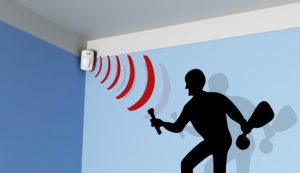When you are looking for home alarm systems and video surveillance to add some solid defense for the basis of your home intrusion systems or business security equipment – video security motion detection plays a pivotal role in your protection. It is important to be able to go beyond home alarms or home security systems and incorporate motion detection signals to your security systems that make you aware when people are potentially trespassing on your property. In preparation for purchasing video camera surveillance equipment, let us help you learn how video security motion detection works to allow you to make the most out of it.
The Motion Detection Process
Part of understanding motion detection is knowing how a video security camera works. There is an image sensor inside the camera that the camera lens directs light towards. When light strikes the image sensor, every single individual pixel records how much light it gets. This pattern of dark and light regions on the pixels composes the total video image that becomes visible.
With motion detection, you select an area that you want to monitor. Sequential images from your video are compared, and if there has been enough pixels that have changed between those video images, the camera software makes the decision that something has moved and sends an alert.
You can preset the sensitivity levels or percentage levels to determine how much motion detection is necessary before you are alerted. The sensitivity level examines the changing light/dark levels. Percentage levels look at the percentage of pixels in the images that have registered a change. Picking the right balance in your motion detection settings prevents you from having too many false alerts or also can improve the sensitivity needed to make you feel assured of your safety.
Video Motion Sensors
Video motion sensors combine video cameras with advanced signal processing: some recordable motion sensors start recording when they sense motion. Video cameras that are controlled by motion sensors allow you to save memory storage by not recording hours and hours of useless footage that has no changes or disturbances in it. Now you will only have to capture the information with distinctive changes involved.
Best Practices for Mounting Sensors
Motion sensors aren’t perfect or error-proof. There can be instances of false alarms caused by errors made by the user, power surges, lightning, electrical failures, insects, animals, foliage, poor application engineering, and faulty equipment. Keep PIR sensors 10-15 feet away from heating vents, where sunlight shines in, and radiators. Motion sensors can detect between 50-80 feet. Therefore, place motion sensors at all entrances and areas where people have to walk through, so intruders will trip the sensor no matter which direction they are headed – like the master bedroom or where ever valuables are located.
Also, we aware that motion sensors tend to work best when trespassers walks parallel to the sensor, not directly toward it. Look for walls that a burglar would walk alongside, like hallways or narrow pathways that would take them towards a room.
Audio Video & Security
13800 Coppermine Rd., Suite 392
Herndon VA 20171
Call: 703-858-5558
www.avandsecurity.com










